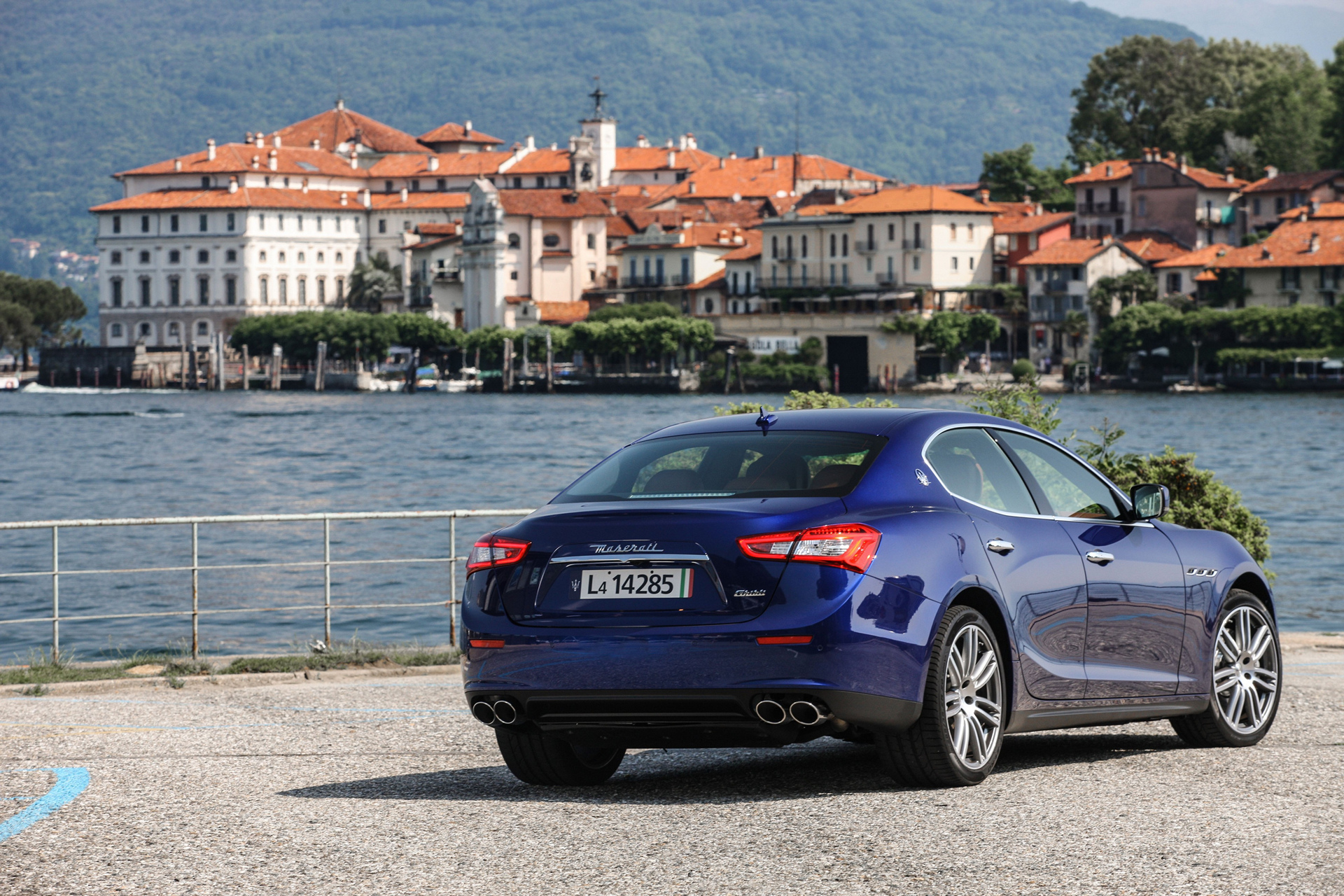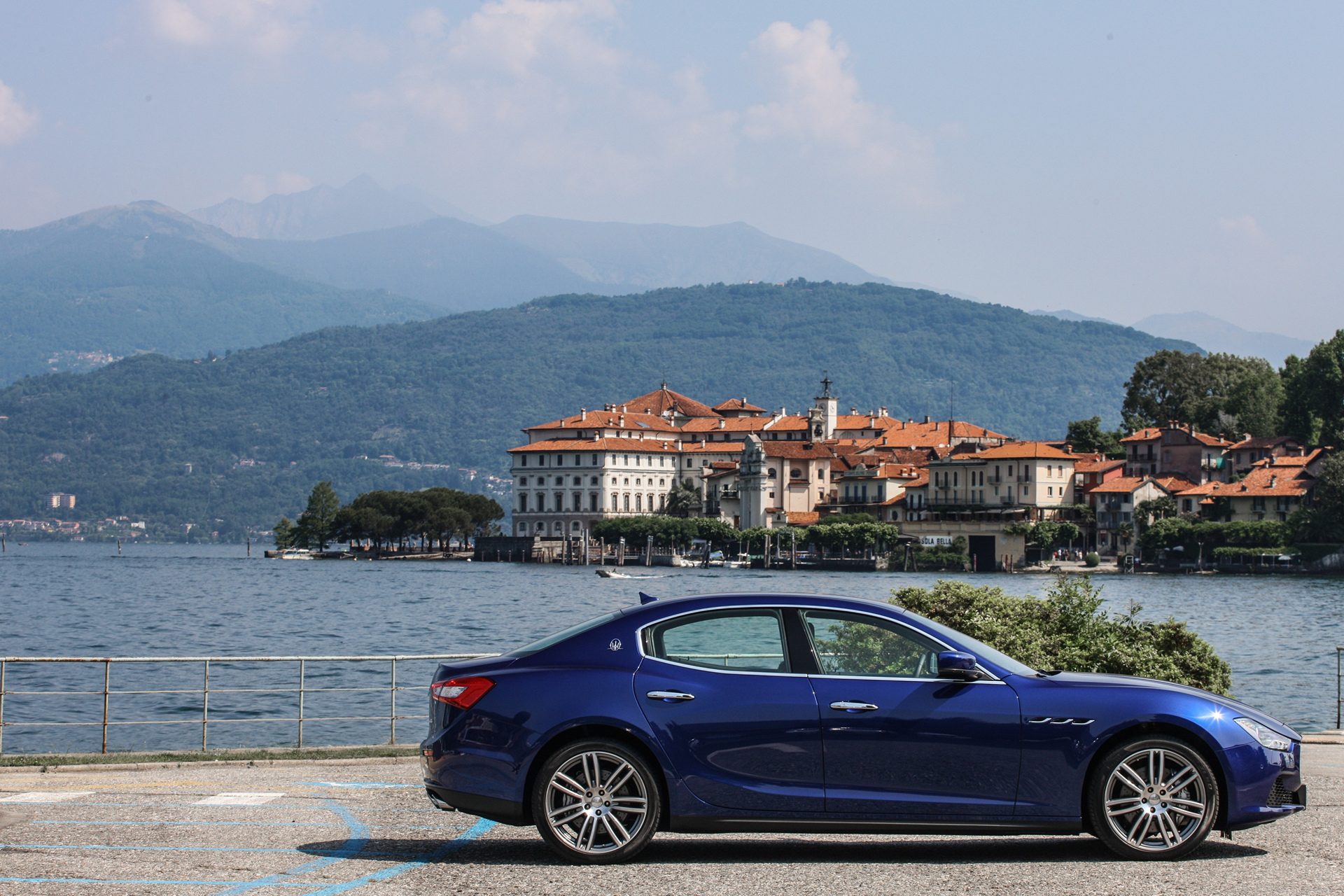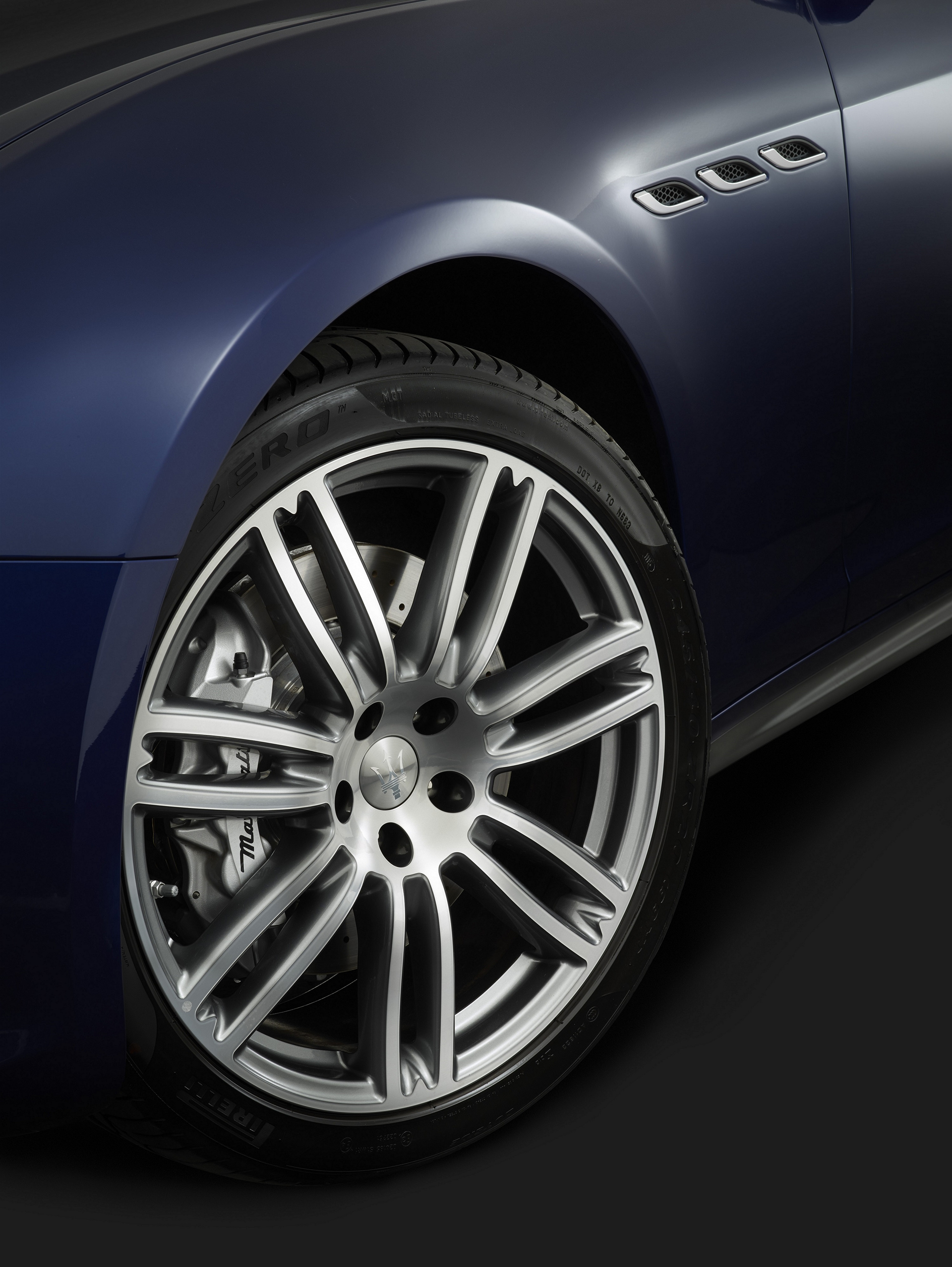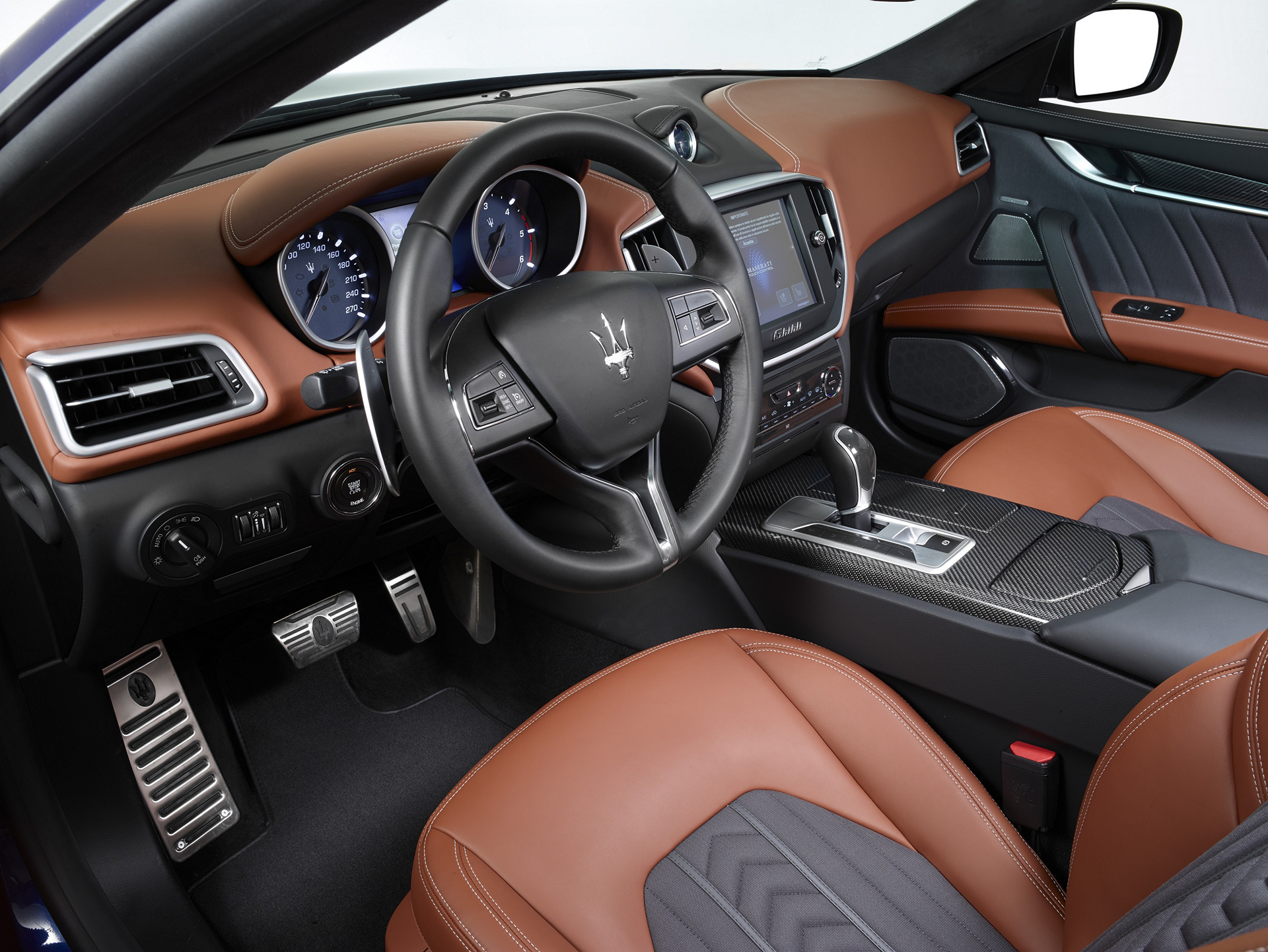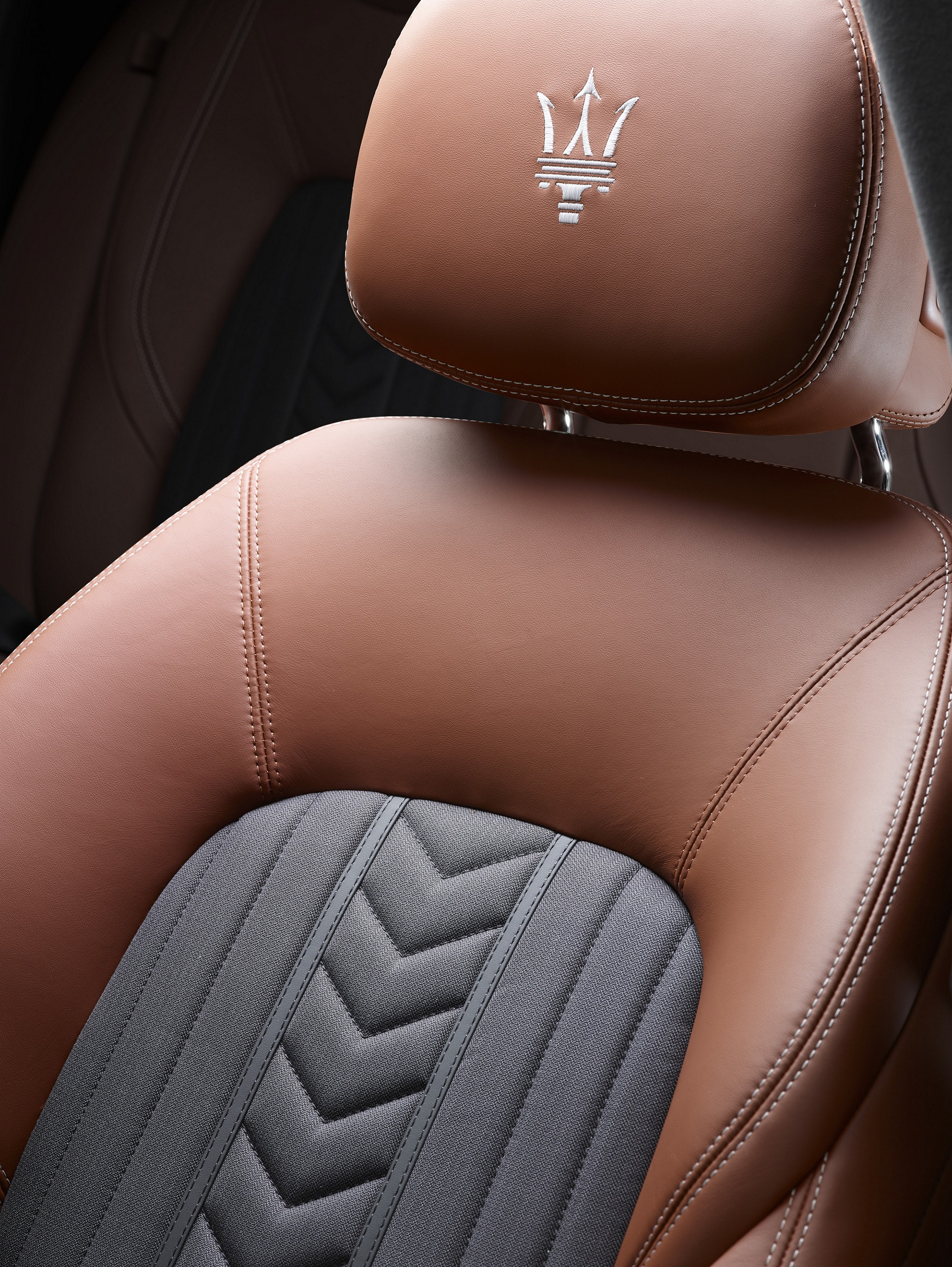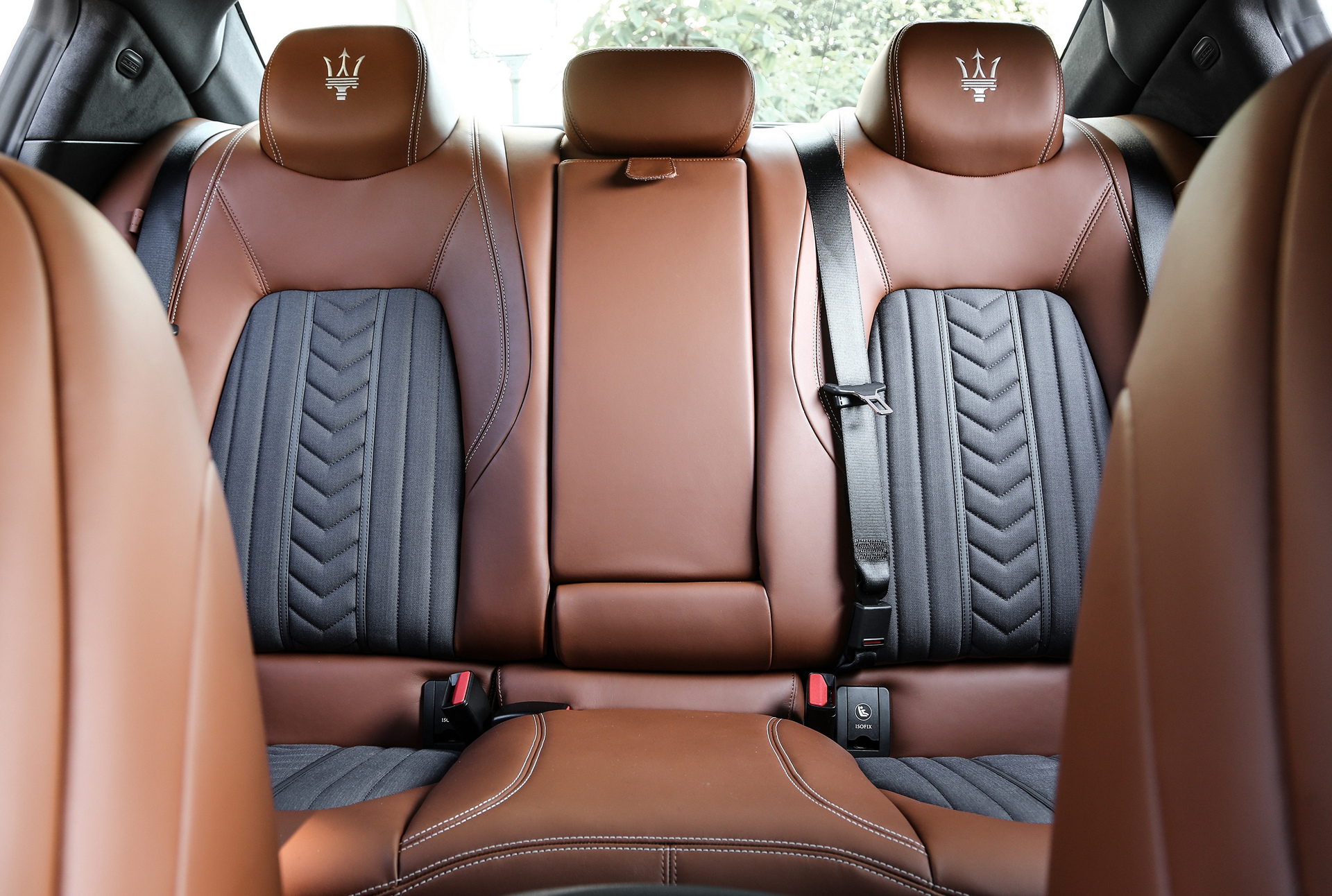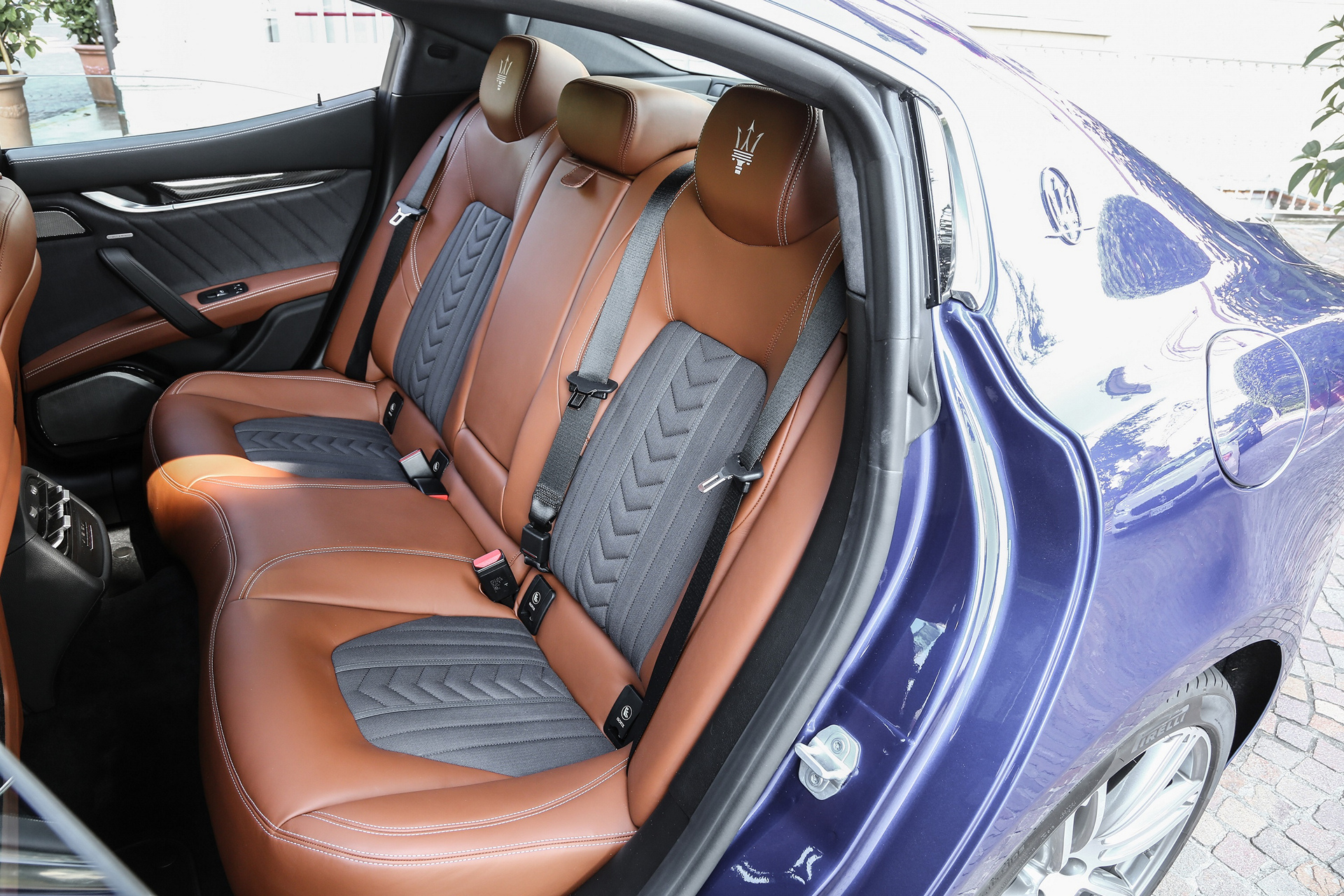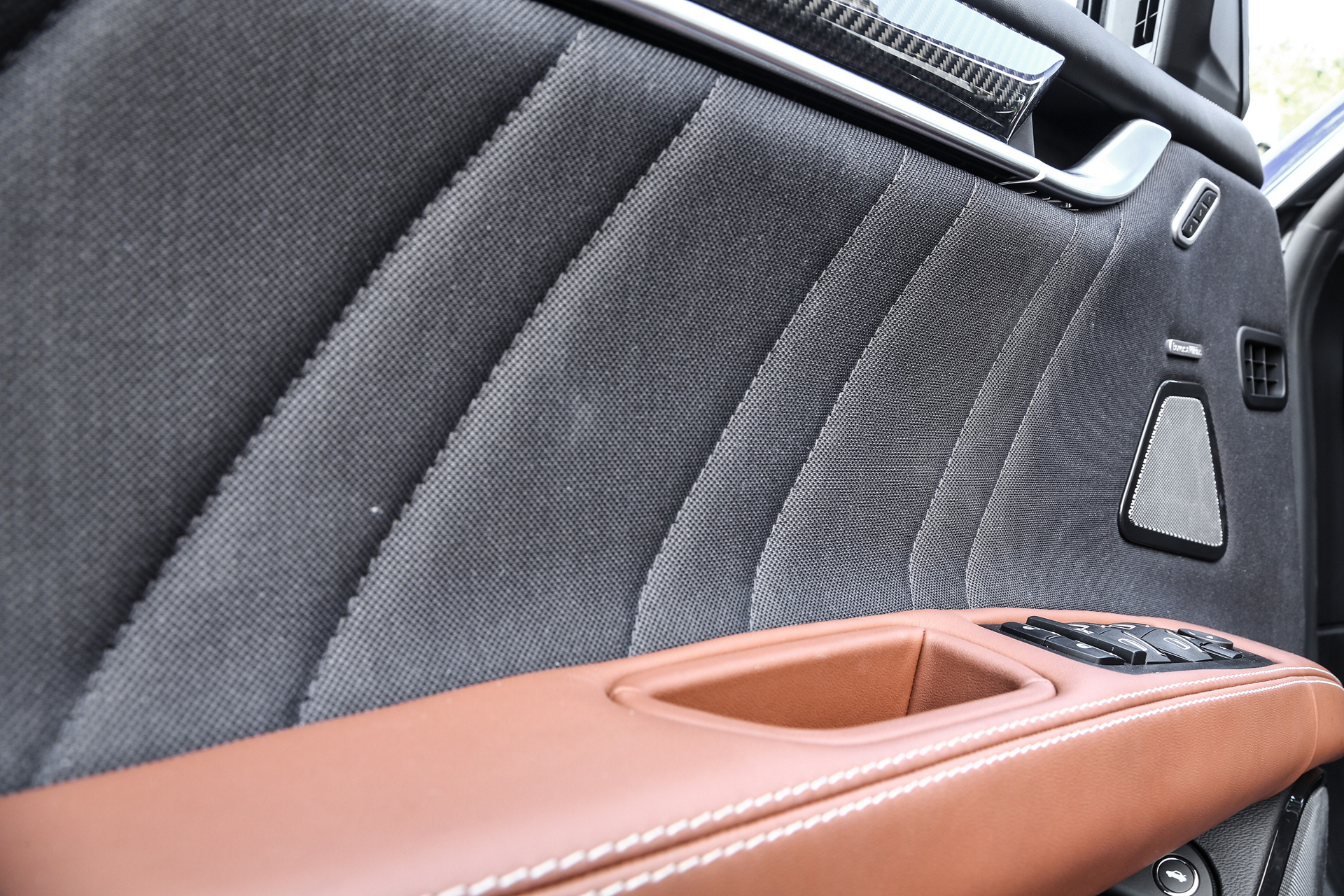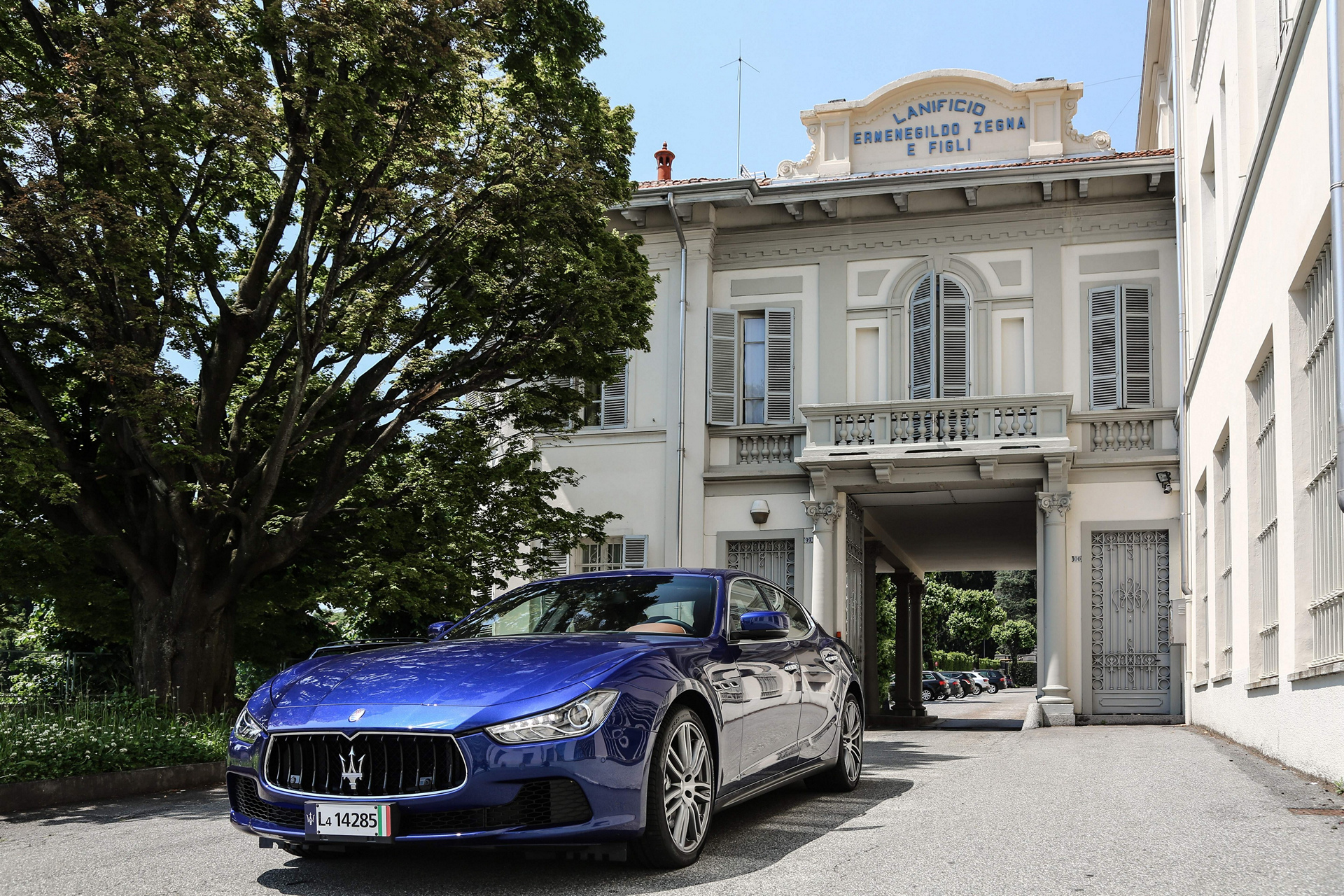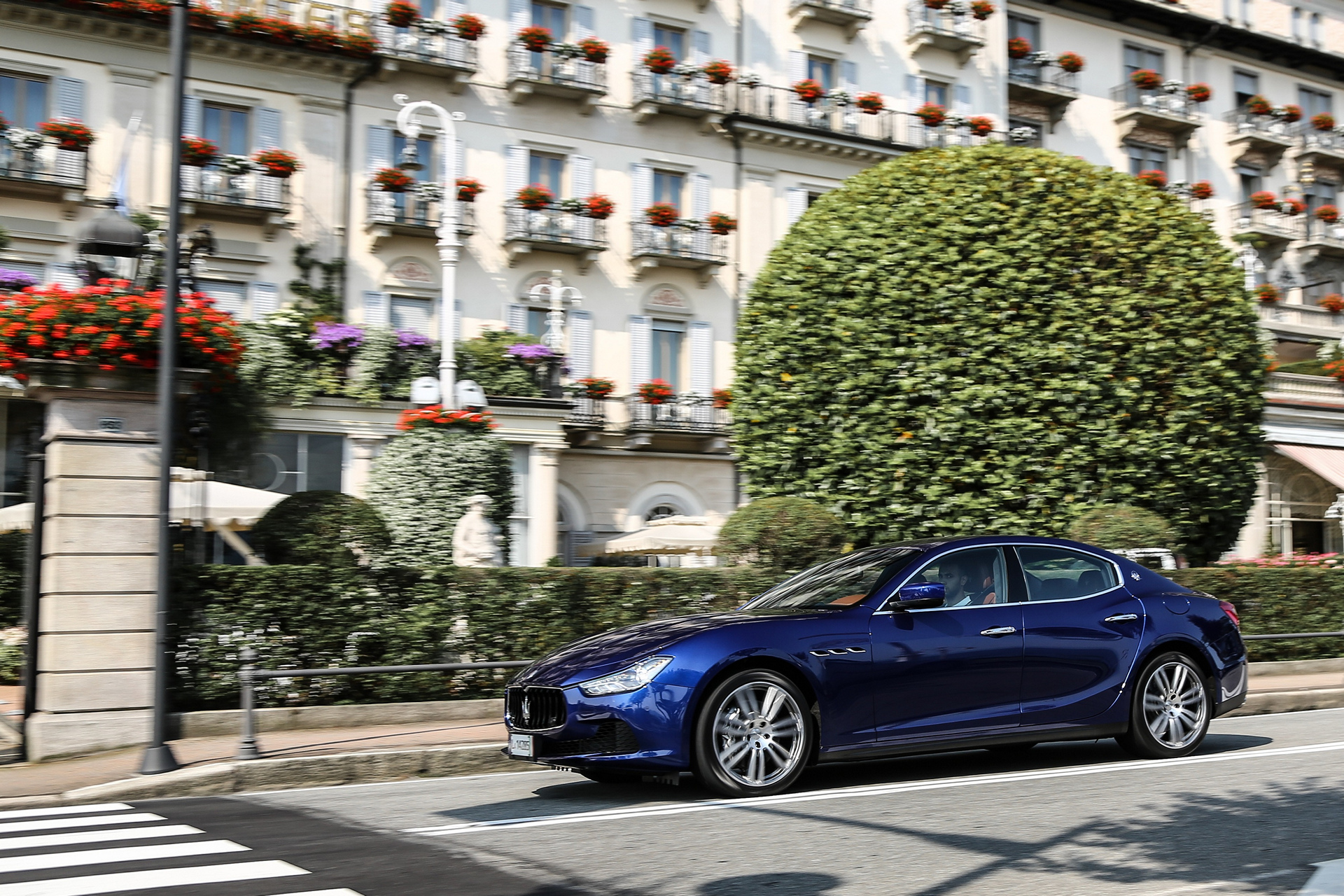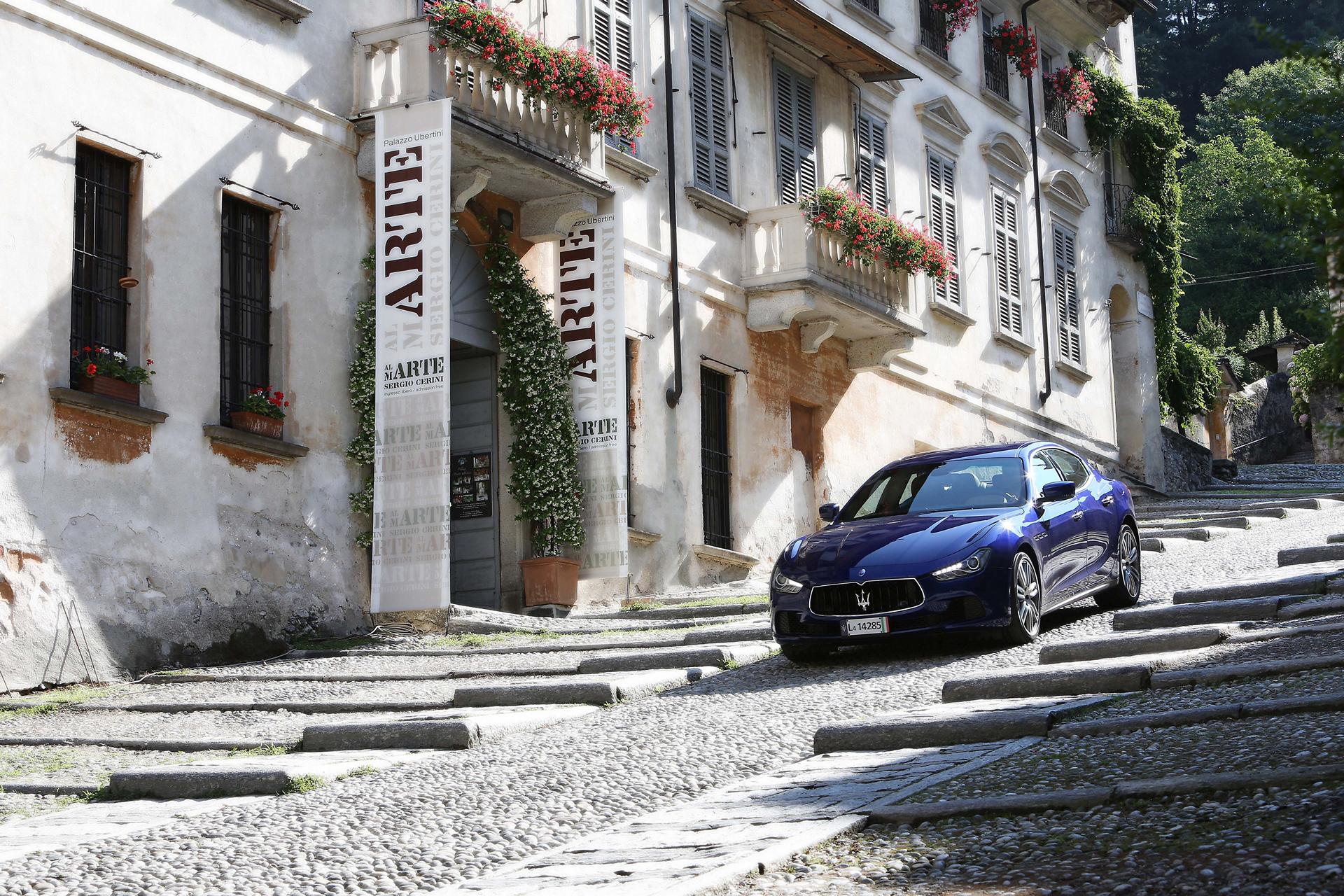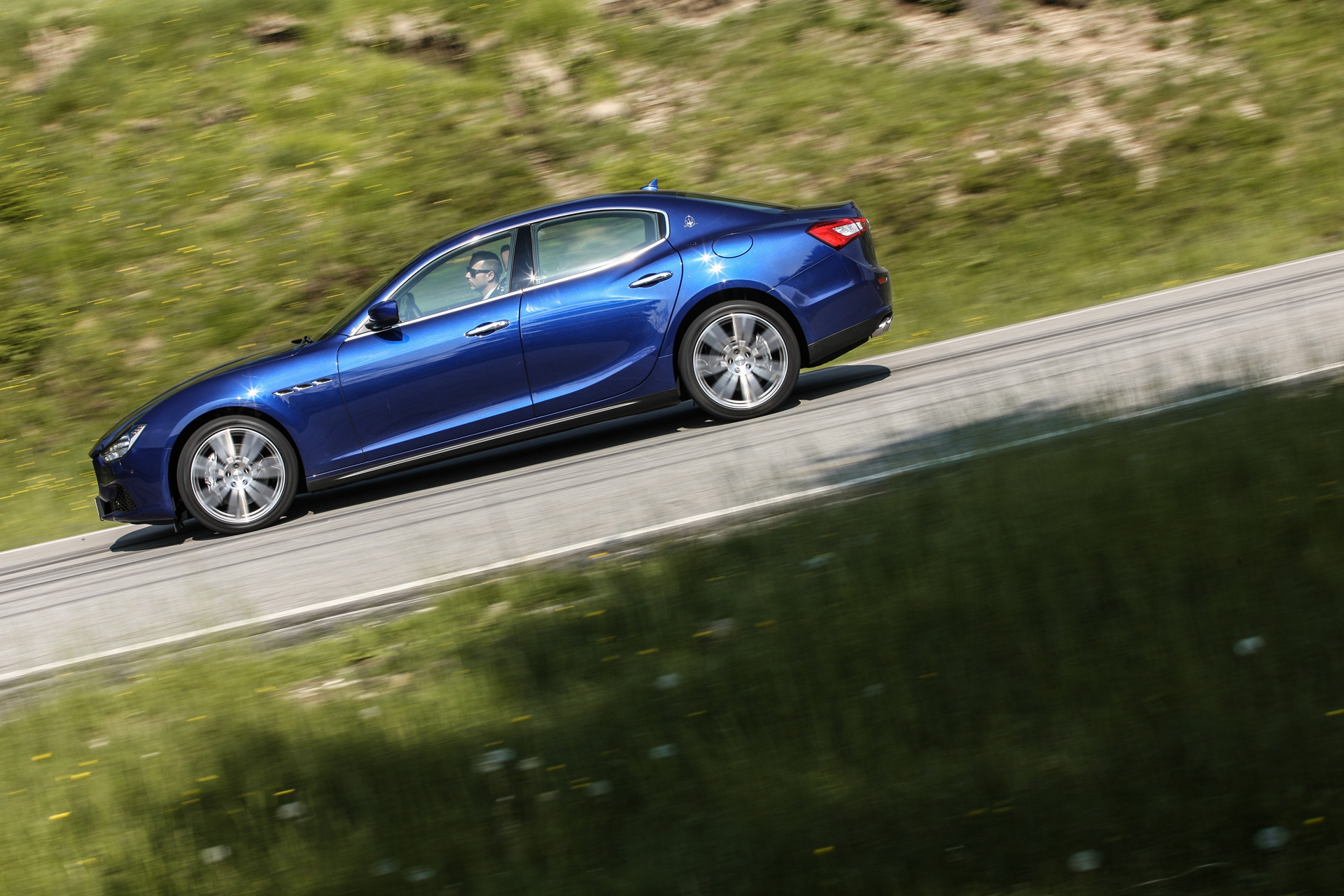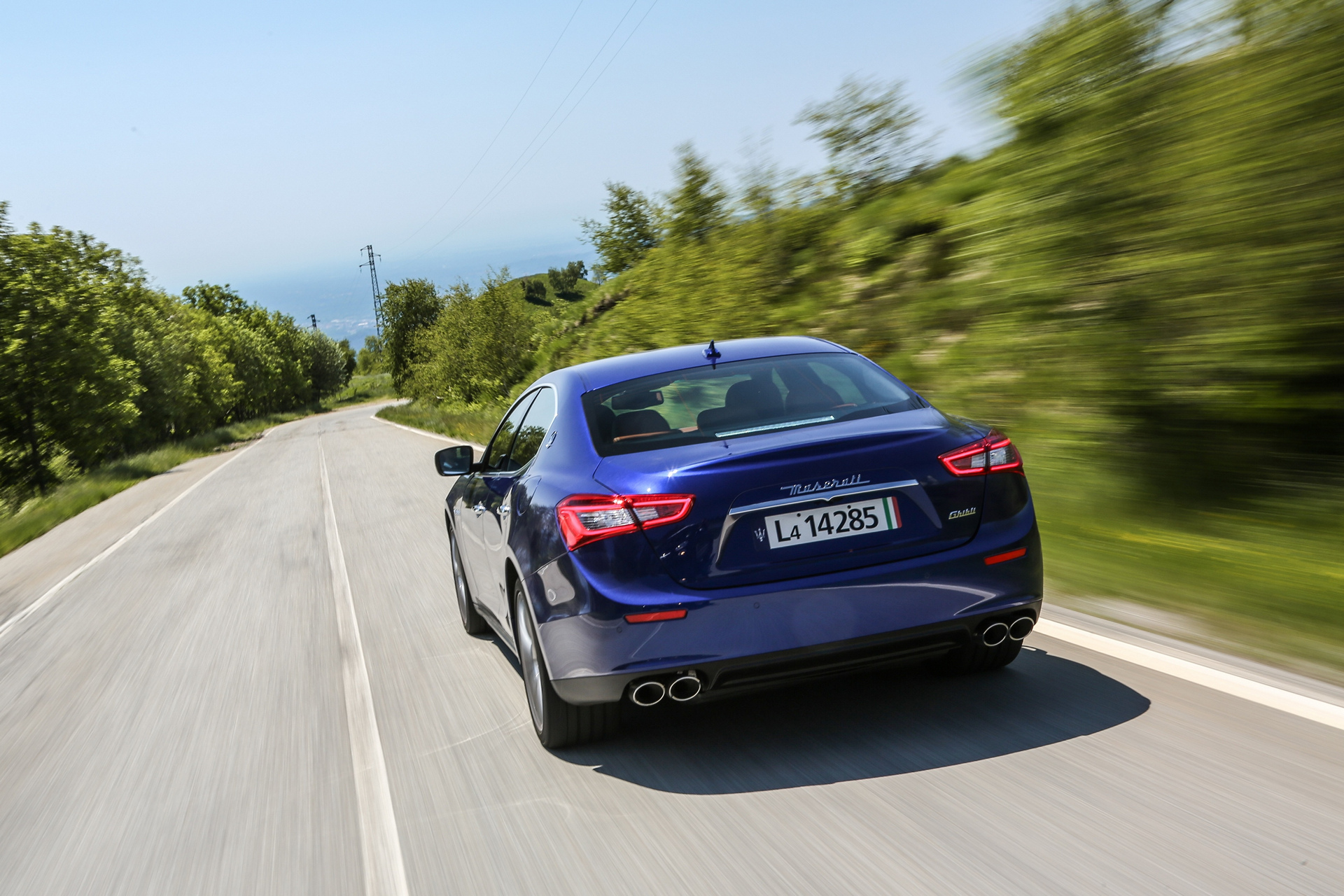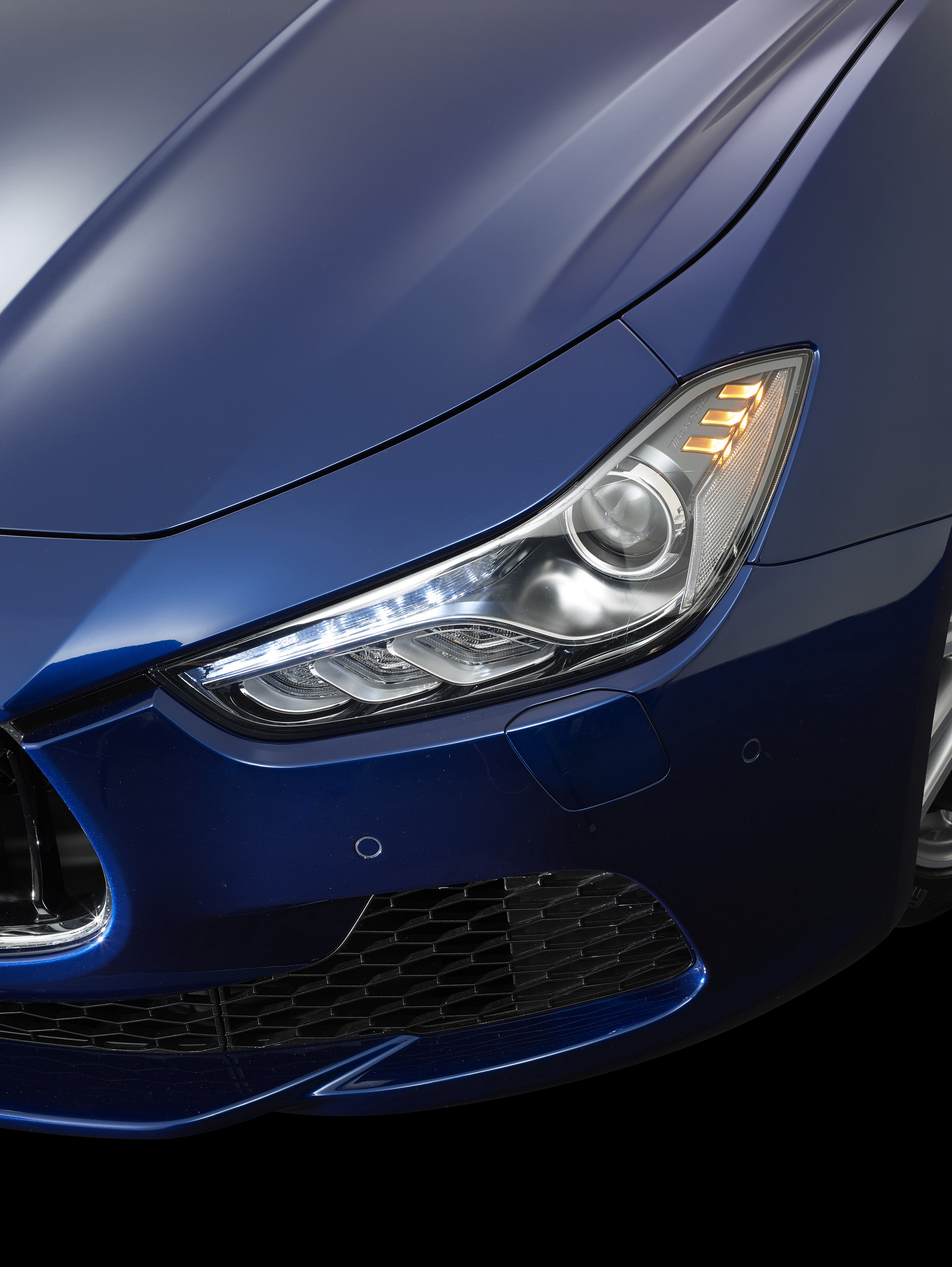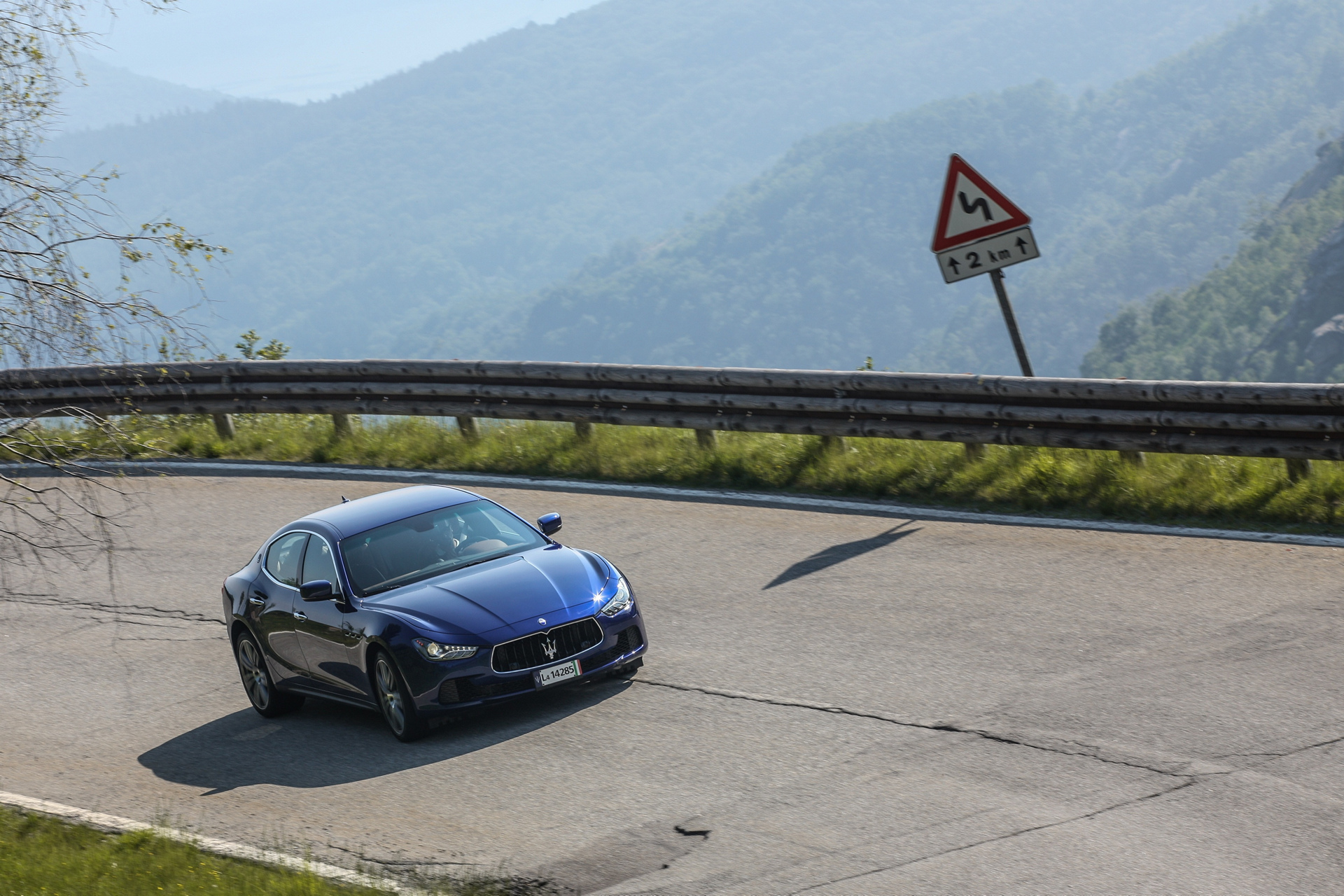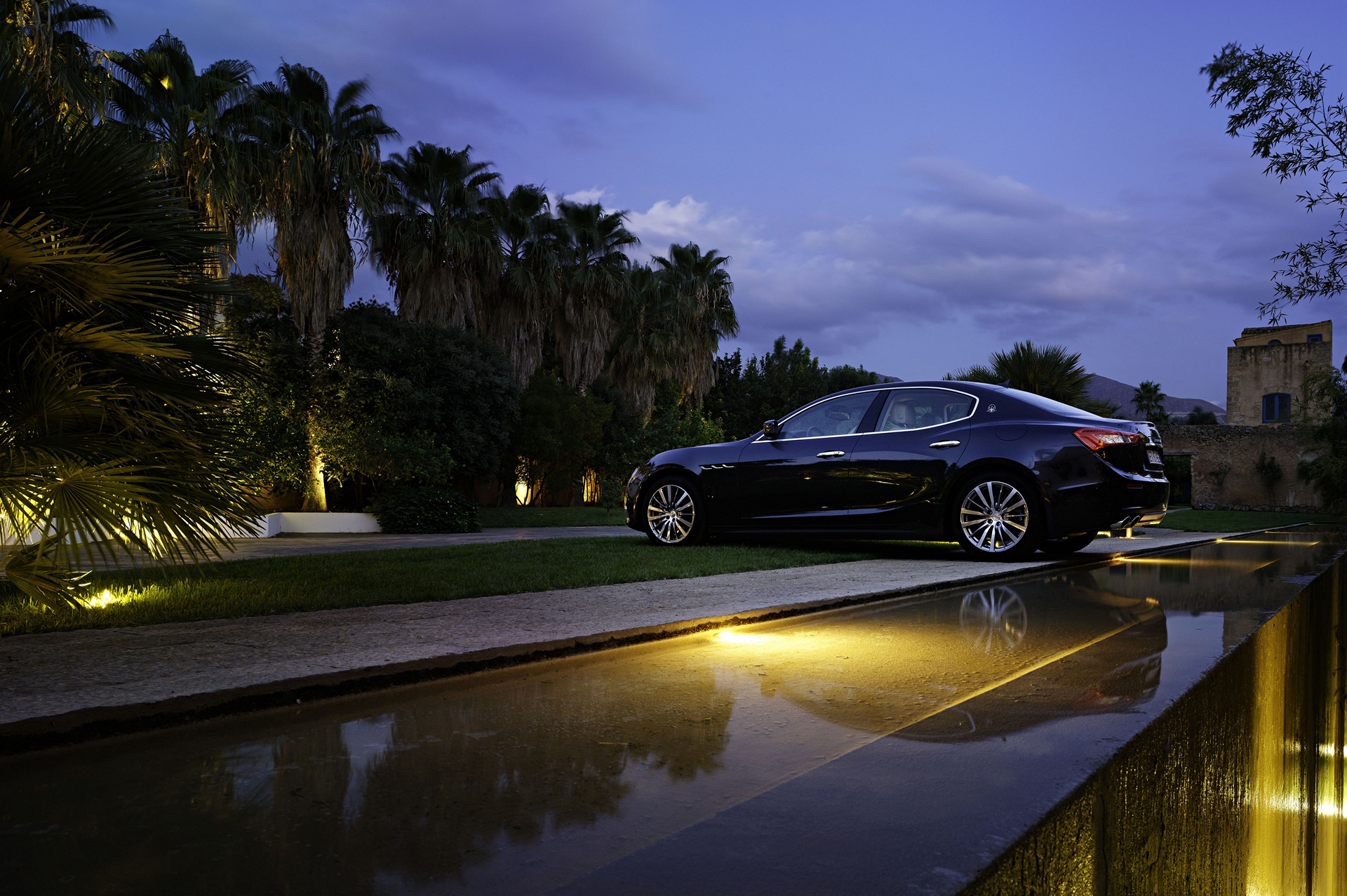When designing the Maserati Ghibli, Maserati drew on its rich experience as creators of the finest grand touring cars in history. The very first Gran Turismo was a Maserati, and since then, every car bearing the Trident has offered thrilling performance and unmatched style. The Ghibli, Maserati’s newest creation, is an extraordinary sports sedan that blends the soul of a GT with a powerful new shape that delivers excitement, every time you drive.
Engine
The Maserati Twin Turbo V6 engine featuring the latest GDI (Gasoline Direct Injection) technology forms the beating heart of the Ghibli.
The engine was designed by Maserati and is being manufactured by Ferrari in Maranello for exclusive use of Maserati. This new-generation engine is powerful, exciting to drive and eco-friendlier, with the EURO 6 homologation introduction and the Start&Stop technology.
The Ghibli features the 2,987 cc V6 engine, which shares part of its technology with the 3.0-litre V6 engine available on the Quattroporte S. It uses the same gasoline direct injection technology, cylinder architecture and combustion technology along with two low-inertia parallel turbochargers and four continuous camshaft phasers.
A characteristic feature of this Maserati engine family is the 200 bar direct fuel-injection system. This very high pressure helps atomise the fuel, thus improving the fuel-air mixture and optimising combustion at higher engine speeds.
The Ghibli has two intercoolers – one to feed each of the turbo chargers –mounted low on either side of the main radiator to catch a constant supply of fresh, cool air.
The second turbocharged 3.0-litre V6 gasoline engine available on the Ghibli delivers 330 hp at 5,000 rpm, a fuel economy of just 8.9 litres/100 km with 207 grams of CO2 emissions/km, and is capable of accelerating to 100 km/h in just 5.6 seconds.
Maserati Powertrain has implemented on-demand ancillaries, with a variable displacement oil pump that works under electrical control for improved consumption and performance. The Ghibli also features the I.C.E. (Increased Control & Efficiency) strategy, a function aimed at reducing consumption, emissions and noise. It delivers a softer pedal response for smooth driving, cancels the turbocharger’s over-boost function and keeps the exhaust’s Sport flaps closed until 5,000 rpm. It also adjusts the gear changes to make them softer and slower and reduces torque at each gear’s take-up point.
Exterior Design
While the Ghibli features all classic Maserati design traits, its exterior emphasizes its determined personality.
The outline of the body reflects a coupé-like philosophy for the four-door sedan, while there are noticeable feline hints around the Ghibli’s grille and headlights. The pronounced grille draws a line back to the iconic A6 GCS of the 1950s. The shape of the headlights converges onto the Trident symbol, with every angle designed to attract the eye to Maserati’s legendary brand. The distinctive C-pillar delivers much of the Ghibli’s coupé-like stance and hosts the classical Saetta Maserati logo, carrying on a tradition dating back to 1963. The side profile is dominated by the swage lines, meaning the lines in the bodywork that give the sides their muscular impact; they run from the unmistakable Maserati air vents behind the front wheels and finish in the mudguard and rear lights, without intersecting.
With the longest wheelbase in the category, a total length of 4.97 m and wide tracks, the Ghibli demonstrates a perfect blend of sportiness and elegance that is second to none in its class.
Its dominant appearance is underlined by a wide track of 1,635 mm. Compared to the Quattroporte the Ghibli is 291 mm shorter, 20 mm lower and 50 kg lighter.
The Ghibli can be fitted with a selection of rims ranging from 18- to 21-inch sizes, all enhancing the car’s visual appearance and engineered to lower the unsprung mass, which improves grip and handling. While the 18’’ and 19” and the majority of 20” alloys rims are crafted using flow-forming technology that reduces the core thickness of the wheels and prioritizes light weight without sacrificing stiffness and strength, the 21” and a new 20” design rims are in forged alloy for even lighter weight and thinner spokes.
Interior Design
The Ghibli enters the E-segment of the sports premium market with a tangible advantage in cabin craftsmanship and detailing. It also sets itself apart with a unique, cockpit-inspired dashboard design that perfectly matches its sporty, driver-oriented character without compromising on refinement and sophistication typical of every Maserati. Key elements such as the central 8.4″ Maserati Touch Control, through to the finishes, including an optional combination of the finest leather with 100% natural fibre Zegna Mulberry Silk inserts on various areas, all underline the cabin’s timeless sporting character. Other optional features include the high-definition Harman Kardon sound system or the extremely powerful Bowers & Wilkins alternative with 15 speakers: new for the Model Year 16 are the Blind Spot Alert system, which warns of vehicles in the blind spot area when overtaking, the power boot lid and a wide range of customization options that cater for the most demanding individuals.
The variety of materials to choose from includes wood trims, carbon fibre inlays, different leather qualities and colours as well as Alcantara headlining; new from MY16 is also available a Black Piano lacquered finish and the chance to include also for headrest the Trident sewed with contrast stitchings.
The Ghibli’s interior is built around a driver interface that is intuitive, uncluttered and simple to use. The instrument cluster features a large rev counter and a large speedometer (both analogue), alongside a 7” TFT display. Major dynamic functionalities are incorporated into the key buttons alongside the gear lever, while other on-board settings can be set via the Maserati Touch Control (MTC) at the centre of the dashboard, or the steering wheel controls for the 7″ TFT display.
The Ghibli provides class-leading front legroom and despite its coupé-like silhouette, comfortable head and leg room for all occupants.
The clever interior packaging also incorporates 60/40 folding rear seats and a 500 litres of luggage capacity alongside the practical, climate controlled centre console compartment, large door pockets and a large climate controlled glove box facing the passenger. A large central tunnel separates the front seats and contains two cup holders as well as a 12 V power socket; the console houses a compartment for mobile phones as well as USB- and Aux-In sockets.
The driver’s seat in the Ghibli offers six-way electric adjustment, while the Ghibli S features an even more supportive seat with eight-way electric adjustment. Preferred seat, lumbar and mirror settings can all be saved and recalled at the touch of a button.
The Ghibli’s rear seats (3 places) provide optimized lateral support and guarantee comfort even on long journeys. The foldable central armrest houses two cup holders and a storage box. The rear is equipped with ISOFIX fittings to securely anchor child seats.
Ermenegildo Zegna Interiors
The Ermenegildo Zegna interior exclusively for Maserati combines fine grain leather with 100% natural fibre Zegna Mulberry Silk inserts on the seats, door panels, roof lining, sunshades and ceiling light fixture. Available in three colour variants for the interiors of the Ghibli, this exclusive outfit is the most exquisite of all Maserati customisations.
The interior is designed around the passenger compartment’s two-colour, two-material concept, with fine grain leather combined with Ermenegildo Zegna 100% natural fibre Mulberry Silk inserts, which give it a distinctive, elegant personality.
Silk, an inherently sophisticated material, is further embellished by the hand-stitched macro-chevron; on the door panel, too, the matching salt and pepper silk jersey is enhanced by an alternating rib embroidery.
As for the seating, the extra fine grain leather with contrasting, light grey stitching, is matched to a central silk insert with a micro-chevron weave of vertical rolls on the central seat and backrest area, within which the central roll, with leather tapes on the sides, features a special macro-chevron weave adding to its three-dimensional feel and technical look.
On the door panels, the central parts are covered with Zegna silk Jersey and embellished by a diagonal roll pattern, with ton-sur-ton ornamental stitching and alternating rib embroideries. The same fabric is used to cover the car’s roof lining and sunshades, the latter carrying grosgrain “Ermenegildo Zegna Exclusively for Maserati” brand labels on the inside. The sophisticated, luxury finish of the car interior is also expressed by the headrests, featuring an embroidered Trident emblem and contrasting stitching.
The interior offering includes a choice of colour combinations: the Ermenegildo Zegna silk, always in Anthracite colour, can be combined with three different shades of luxurious fine leather, for three individual looks:
Black colour fine grain Leather / Anthracite Ermenegildo Zegna Silk / contrasting grey stitching on seats, dashboard, door panel and headrest
Natural colour fine grain Leather / Anthracite Ermenegildo Zegna Silk / contrasting grey stitching on seats, dashboard, door panel and headrest
Red colour fine grain Leather / Anthracite Ermenegildo Zegna Silk / contrasting grey stitching on seats, dashboard, door panel and headrest
This extended, exclusive product offering for the Maserati sedans is available for all markets with effect from autumn 2015, on all Quattroporte and Ghibli versions.
Key Features
Maserati Touch Control (MTC)
The MTC’s 8.4″ Touch Screen display comes as a standard on Ghibli and allows the user to intuitively control almost all of the on-board equipment such as CD-/DVD-player, radio and navigation as well as Bluetooth mobile phone connections. Large icons at the bottom of the screen guide to the various menus. The MTC also controls the front seat heating and ventilation if equipped, the steering wheel heating and the operation of the optional rear window shade, as well as providing the screen for the reversing camera. The MTC is equipped with Aux-In and USB sockets as well as a SD card reader.
Siri Smart Personal Assistant
Due to the Apple chip contained into the MTC, from MY16 a usable feature that exploits iOS functionality – an intelligent personal assistant – has been introduced. Based on Bluetooth technology, Siri allows users to perform iOS connected devices tasks and make requests using voice commands. For this in-car application and for related safety reasons, while driving, responses that contain visual information or require user interaction will be blocked and Siri will only respond with suitable audio feedback and voice commands. The advantage is that Siri uses natural language to understand commands.
Wi-Fi Hotspot
The Ghibli can contain optional WLAN technology that effectively turns the car into a Wi-Fi Hotspot.
Owners can place a SIM card into its WLAN router to receive Internet signals, which can be resent around the car as a wireless Internet signal. Up to three devices can be connected simultaneously.
Audio systems
The standard 8-speaker audio system can optionally be upgraded to a premium sound system, branded Harman Kardon with 10 speakers and a 900 Watt amplifier. The extra 300 Watts compared to the previous system, the esthetical differentiation with the black finish grille pattern on the door’s woofer with the Harman Kardon logo, the new 12-channel amplifier in conjunction with a high-performance subwoofer represent the best trade-off between sound clarity and performance.
Maserati also offers those who insist on the very top in hi-fi the option of the Bowers & Wilkins Premium Surround Sound system, with 15 speakers, a 1,280 Watt amplifier and a perfectly configured QuantumLogic™ Surround.
New from MY16 is the technical Clari-Fi function; an advanced solution thought for digital music and capable to restore the artistic details lost in your digitally-compressed songs. Clari-Fi scans all types of compressed audio files for lost music details, supporting MP3, AAC, Satellite Radio, Playback and Streaming Music Services and intelligently corrects waveform deficiencies based on existing music information and audio source quality. By recapturing the missing highs and lows, restoring the vocals to their natural tone, returning to a true stereo sound and removing unwanted distortions and artifacts, these features exclusive for the Bowers & Wilkins Premium Audio system set a new benchmark in automotive audio.
The system perfectly reproduces every nuance of the sound, with a dynamic purity at the highest level.
As the QuantumLogic™ Surround Sound system processes each track, individual elements such as musical instruments and voices and the interior’s reverb, are identified, separated and processed into a surround sound field which is exceptionally realistic and precise and creates perfectly defined audio image.
The Bowers & Wilkins Premium Surround Sound system features a central 100 mm Kevlar cone for midrange sound and three 25 mm tweeters at the centre and sides of the dashboard. The front doors house a 165 mm woofer and 100 mm Kevlar cone midrange speaker, while the rear doors each carry a 165 mm Kevlar woofer and 25 mm tweeter. The rear shelf has two 100 mm Kevlar midranges and a 315×200 mm subwoofer.
Exhaust system
In the best Maserati tradition, sound and performance of the Ghibli’s exhaust system are controlled by pneumatic valves in the pipes emerging from each bank to maintain the rich aural tradition of the brand.
In Normal mode, the bypass valves are closed up to 3,000 rpm to give a comfortable and discreet engine sound, which emerges through four sport exhaust tips.
The Sport mode not only adjusts a variety of handling parameters, but also opens the exhaust valves, giving the shortest possible, high-energy route for the exhaust gases, which gives the Ghibli its maximum engine performance and the unique Maserati engine sound.
ZF Eight-Speed Automatic Transmission
All versions of the Ghibli are fitted with the same ZF AT8 – HP70 eight-speed automatic transmission, also installed on the Quattroporte. The transmission caters for all demands, from comfort to fast gear shifting, and from minimized fuel consumption to low NVH (Noise, Vibration and Harshness). There are five dedicated shift modes: Auto Normal, Auto Sport, Manual Normal, Manual Sport and I.C.E. mode.
Auto Normal is the Ghibli’s default setting and performs its gear changes with smooth shifts at low engine speeds to emphasize the car’s comfort and to minimize fuel consumption.
The Auto Sport mode sees the transmission switch the drive character to change gears with greater alacrity at higher engine speeds and delivers a distinct gear engagement to enhance the powertrain’s sporting feel.
The car also recognizes a variety of conditions, such as whether the car is travelling up or down hill, is braking hard or is driving through a corner, and selects the best gear and the best gear-shift style accordingly.
The transmission can also be controlled manually by selecting the M button on the transmission tunnel.
In Manual Normal mode, the driver can change gear with either the elongated gearshift paddles besides the steering column or by using the gear lever. The driver is in charge of the gear selection, though the system will intervene and change to a lower gear if the engine revs drop too low or change to a higher gear if the engine revs climb too high.
In Manual Sport mode gearshifts are at their fastest and crispest, giving the driver full control of the powertrain. The system will not intervene, even if the driver strikes the engine’s rev limiter. It will only intervene if the engine’s revs drop too low to be effective in a given gear.
The I.C.E. (Increased Control & Efficiency) mode is designed for remarkable fuel economy, relaxed driving and extremely low grip conditions. The transmission changes gear as softly as possible, both going up through the gears and returning back down.
All gearshift modes can be selected via buttons on the left of the gear knob.
Limited-Slip Differential
The Ghibli is the only car in its class to use a standard mechanical limited slip differential in all of its versions in order to deliver the best inherent traction in all driving situations.
The bevel-drive, asymmetric unit offers 35 per cent lock-up under power and 45 per cent under release.
The rear differential is driven via a two-piece, 80 mm-thick light-weight steel prop shaft with two constant velocity joints and a head rubber coupling, which runs through a cross member-mounted rubber bearing for lower NVH levels without compromising rigidity.
Body
The Ghibli’s body and underbody design fulfil the sporty promise of its appearance. With a low drag coefficient of 0.31 reducing fuel consumption low and increasing stability at high speeds.
Chassis
The chassis of the Ghibli shares its core architecture with the Quattroporte and has been precisely designed to meet the performance and comfort demands of Maserati buyers while maximizing safety aspects.
Based around a rigid and extremely secure steel cell, it uses an array of different steel and aluminium alloys, each designated a precise task to maximize strength, minimize weight and retains the sports sedan’s perfect 50:50 weight distribution models.
The front of the chassis features an aluminium casting, with a reinforced cross-strut which helps deliver outstanding rigidity in all directions, while the rear of the chassis is made from rolled steel.
Accordingly, all four doors and the bonnet are all made from aluminium. Ultra-light weight magnesium is used in the dashboard’s cross strut.
Suspension
Double wishbone suspension layouts are a race-bred tradition at Maserati and the Ghibli continues with this heritage but also incorporates some new technologies.
Utilizing a suspension layout and software system that has already proven its qualities in the Quattroporte, the Ghibli has high-mounted all-aluminium double wishbones at the front to guarantee light and precise handling characteristics. The geometry of the system has delivered a quadrilateral architecture, which has enabled Maserati’s handling team to deliver steering that is precise, communicative and comfortable.
The rear suspension employs a five-bar multi-link system, with four aluminium suspension arms, and has achieved the conflicting targets of executive ride comfort and sports performance.
The Ghibli’s suspension package is based around a fixed rate damping system to control the movement of its steel springs and anti-roll bars.
The Ghibli is also available with the option of the Skyhook adaptive damping system, where all four dampers can now be electronically controlled independent of each other.
The default mode for the Skyhook system prioritizes comfort, and then becomes more athletic if the driver presses the suspension button. This extra damping stiffness pushes the Ghibli’s handling to even higher levels and its tune was developed in both extreme test scenarios and on the racetrack. Essentially, it drastically reduces both longitudinal and lateral load transfers and minimizes body roll to bring out the sportiest side of the car’s character. The computer system in control of the Skyhook dampers monitors an enormous array of parameters including, speed and lateral and longitudinal acceleration, individual wheel movements, body movement and damper dynamics. Adjusting also to suite the suspension mode chosen by the driver, the system delivers the perfect damping mode for each wheel almost instantly.
On the Diesel and S Q4 versions only, the Ghibli also offers a single-setting racing-style suspension system. As well as lowering the car’s set-up by 10 mm, this solution also includes special, stiffer springs and variable damping hydraulic shocks.
Brakes
The Ghibli and the Ghibli Diesel feature four-piston brakes with fixed alloy Brembo calipers and 345×28 mm ventilated discs in the front; floating calipers with 320×22 mm ventilated discs in the rear.
The brakes on the Ghibli S and S Q4 versions are 360x32mm ventilated and cross-drilled Dual Cast type with six-piston fixed alloy Brembo calipers on the front axle, while the rear axle is fitted with four-piston fixed alloy Brembo calipers of 350×28 mm.
The Dual Cast technology, pioneered by Maserati, allows the weight of the cast-iron braking surface area to be offset with an alloy hat to minimise unsprung mass.
These brakes have a large swept area, highly efficient cooling, are designed for consistent performance in sports driving situations.
The Ghibli stops from 100 km/h in 36 metres. But high-performance stopping power is only one measure of overall braking performance and the collaboration with Brembo also concentrated on optimizing the acoustic comfort of the Ghibli’s breaking systems.
Besides being effectively forceful, Maserati brake calipers have also always added a significant stylistic effect. The choice is wide: they are available in a sporty red, Maserati blue, the conventional metallic grey and black or the exclusive hand-polished aluminium.
Steering System
The Ghibli uses a technological aluminium steering box, developed specifically for the performant front-suspension geometry, to deliver more response, more consistency at high speed and easy manoeuvring at low speed. This allowed Maserati’s suspension engineers to deliver extreme precision combined with the steering sensitivity needed for turning into corners at high speeds.
It also has a reduced steering ratio, which delivers an agility that is rare for this class and while it is comfortable in all situations, the steering feel is geared up towards driving enjoyment.
In line with the feedback from customer demand, Maserati has bypassed the trend to electro-hydraulic steering systems. The Ghibli employs a speed-sensitive, servo-powered hydraulic system that prevents unpleasantly artificial assistance when the driver turns the wheel quickly.
Maserati Stability Program
Maserati drivers have long known the benefits of the Maserati Stability Program (MSP) and the Ghibli’s system has been further refined.
Developed in the most extreme test circumstances, the MSP uses a wide array of sensors to detect any need to intervene on the driver’s behalf.
MSP adds a layer of security on top of the Ghibli’s inherent chassis stability. It constantly measures the car’s handling and grip and combines a host of safety and performance systems to maintain the car’s ideal handling stance.
Two of the main elements of the MSP’s operation are the engine and the brakes. If skidding is detected, the MSP reduces the engine’s torque output and can actuate the brakes with finely varied inputs to restore the car’s stability within milliseconds.
The other key systems that make up MSP include:
• ABS (Antiblock Braking System), which stops the wheels locking up when braking, thereby maintaining steering control at all times.
• EBD (Electronic Brake Force Distribution), to distribute braking force between the front and rear axles to prevent rear-wheel lock up.
• ASR (Anti-Slip Regulation), which stops the wheels from spinning in low-grip situations.
• MSR (Motor Spin Regulator), which prevents the wheels from locking up when downshifting on low-grip surfaces.
• BAS (Brake Assist System), which uses a variety of sensors to recognise emergency braking situations and increases the pressure in the braking circuit.
• Hill Holder, which automatically connects to the braking system to prevent roll back.
Safety
The Ghibli’s passive safety equipment has been designed to achieve maximum peace of mind. The Ghibli achieves five stars on the Euro NCAP crash test, all without compromising its weight or fuel consumption.
Maserati has balanced these conflicting demands by using hot-formed steels in critical areas of the passenger compartment for added occupant safety, while using aluminium in other areas to save weight.
In particular, the front of the passenger compartment (the pillars and under-door mouldings) features hot-moulded steel components, with a magnesium dashboard strut to save weight, while the rear is stiffened with high strength steel.
The crash bars at the front and rear of the car are made of extruded aluminium, while the doors, engine compartment, mudguards and luggage compartment are in aluminium.
Maserati’s engineers added a third crash load path to the front structure of the car to help dissipate load and distribute the forces on the car to guarantee the stability of the body structure in frontal impacts.
The Ghibli is equipped with a seven-airbag system and anti-whiplash front headrests. At the front, two-stage airbags are concealed from the occupants inside the steering wheel and dashboard to protect the head in frontal accidents while a knee airbag protects the driver’s legs and reduces the femur load in crash situations. The chest and hips of the front occupants are further protected by the side airbags beneath the seat leather. The sides of the occupants’ heads are protected by two head “curtain” bags mounted in the roof of the car, next to the B-pillar. The “curtain” bag protects the heads of the front and rear occupants against lateral impact.
The front seats are brimming with safety equipment designed to reduce trauma to the occupant’s cervical vertebrae.
If the car is involved in a rear-end accident, its active headrests automatically reduce the distance between their surface and the passenger’s head.
The front three-point seatbelts are equipped with load-limiting pyrotechnic pre-tensioners, which trip in a collision to hold the passengers securely and prevent or minimize injury.
The front seatbelts are fitted with height adjusters; properly adjusting the height of the seatbelts to the occupant’s height, which is not only more comfortable but also improves the safety function of the device.
Assistance and Safety Features
Blind Spot Alert & Rear Cross Path
The Blind Spot Alert, through visual and audible signals alerts the driver when a vehicle enters the blind spot zones; this important safety feature has been introduced to avoid unwanted collision while the driver change the lane. This system, conceived to reduce the risks involved in changing lane, monitors the blind spot areas using two radarbased sensors, located inside the rear bumper fascia; when a vehicle approaches from behind, the LED warning signal embedded in the side mirrors lights up while a chime alert also sounds.
The area beside and behind the car is monitored at speeds above 10 km/h, in order to avoid unwanted collisions with vehicles such as automobiles, trucks, motorcycles, etc…
The Rear Cross Path function issues the same alerts also when backing out of a parking space; this feature is intended to help drivers back out of parking spaces where their view of oncoming vehicles may be blocked. Using sensors located on either side of the rear bumper, it detects any vehicles or objects that are moving towards the side of the vehicle with a minimum speed of approximately 1 to 3 km/h to a maximum of approximately 16 km/h, such as in parking lot situations.
Power Boot Lid with Hands-Free Mode
With the introduction of the Power Boot lid, the already light constructed aluminium boot lid is now autonomous in its closing phase. With its electric actuators and a motorised latch, the system allows to open or close the boot automatically, ensuring that the lid is locked upon closing.
What’s more, it is possible to open and close the boot lid by simply moving your foot under the rear bumper. In this case and for safety reasons, the lid will open or close only if the “Passive Entry” system acknowledges the presence of the key.
Rear-view Camera
The rear-view parking camera on the Ghibli makes manoeuvring and reversing safer and more comfortable. Installed next to the luggage compartment’s release button, it views the area behind the car, and shows the resulting colour image on the 8.4” MTC display. The system works together with the standard parking sensors and sends an acoustic warning as it approaches obstacles behind the car.
Keyless Entry
In the world of Maserati, small details are everything – right down to the design of the aluminium key, which reflects the Ghibli’s style and incorporates ‘Keyless Go’ technology. Once inside the car, the driver has only to press the ignition button to start the engine. The ‘Keyless Entry’ function enables the driver to open the doors or boot without ever touching the key.
TPMS (Tyre Pressure Monitoring System)
The system continuously monitors the tyre pressure with a sensor mounted inside the rim as part of the valve; the pressure can be read off the display on the dashboard. If case of puncture or changing of tyre pressure, the system notifies the driver with visual and acoustic warnings.
Speed Limiter Function
For a top level safety all the Ghibli cars allow the driver to set a maximum speed limit though the Active Speed Limiter function. It can be activated and deactivated from the button on the steering wheel. If the driver decides to override the limit in extreme situations he just has to “kick down” (providing significant accelerator pedal input) and thus exceed the set speed.
Lighting
The Ghibli’s distinctive headlights are fitted with Bi-xenon and LED daytime running lights. The LED tail light assembly provides excellent visibility adding to the safety aspect.
Headlights
The Automatic Frontlighting System (AFS) actively adjusts the headlight depth to combine an outstanding view of the road with very low glare for oncoming traffic. Each headlight includes LED daytime running lights, with a light shape that provides instant recognisability in both day and night running. Each light also contains direction indicators, LED side position lights and a side reflector.
With a video camera integrated into the rear-view mirror, the lighting system offers a beam control specifically for motorway driving which increases the depth of the light beam without the need for manual high beam activation.
Sensors monitor the driving style and speed and if the road is clear, the beam depth offers the greatest depth and width, combined with the directional rotation of the headlights themselves.
In addition, there are four different automatic lighting setups: for city driving, for motorway conditions, for low visibility and for driving on the opposite side of the road in applicable countries. Each of these modes automatically activates a strategy to best illuminate the road surface. The Town Beam turns on below 45 km/h and sets the beam wider and shallower, giving a better view for turning and for peripheral danger zones while causing minimum disturbance for fellow road users.
Tail Lights
The Ghibli’s tail lights have been designed to offer maximum visibility and to have a recognisable style. These LED lights integrate the position light function in an illuminated ring running right around the tail light itself. Inside this ring are the brake lights, the direction indicators, reversing lights and fog lights. The outside reflector and LED side position lights round off the unit.
Quality control
The Ghibli is built to the latest quality standards, at the very top of the industry, at the Avvocato Giovanni Agnelli Plant, home to state-of-the-art technologies and production processes, at Grugliasco, near Turin. Every single Ghibli runs through a quality assurance test as it emerges from the production line.
Tests during the car’s development phase included:
• More than six million test kilometres with a fleet of more than 90 Ghiblis
• Hundreds of thousands of additional test kilometres to validate any upgrades
• Testing every single component for endurance, quality and noise
• Testing in extreme heat in South Africa and Morocco
• Testing in extreme cold in Sweden and New Zealand
• Severe process control, including four in ‘Body-in-White’, three in painting, four in the assembly process, plus additional electronics, dynamometer and water testing
• A total of more than 700 control checks for each car in production
• Every finished Ghibli has a final, 30-minute quality audit before being delivered to the customer
Every finished Ghibli is tested on-road for 40 km before it is delivered to the customer.
Price
Recommended retail price (MSRP) starts from $70,600




































